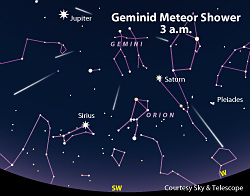December 10, 2002
Contact:
Alan MacRobert, Senior Editor
855-638-5388 x151, [email protected]
Note to Editors/Producers: This release is accompanied by high-quality animations and illustrations; see details below.
An old, reliable meteor shower is heading our way. The annual Geminids should reach peak activity late on the night of December 13–14 (late Friday night and early Saturday morning).
Along with the better-known Perseids of August, the Geminids are the strongest of the reliable annual meteor showers that hardly change from year to year. Sky & Telescope magazine predicts that under good sky conditions late on the peak night, you might see a "shooting star" every few minutes on average.
The Geminids won’t be a match for the recent Leonid shower — which produced half a dozen or more meteors per minute for observers who were watching under good skies at the right time on the morning of November 19th. But if meteors are what you want to see, the Geminids are almost sure to serve up a nice helping.
The time to watch will be anytime from about 10 p.m. Friday evening, December 13th, until the first light of dawn on Saturday morning. Moonlight will wash the sky and compromise the view until about 2 a.m. (depending on where you live in your time zone). So the very best time will be the wee hours between moonset and dawn. (Dawn begins about 90 minutes before your local sunrise.)
You’ll need no equipment but your eyes. Find a dark spot with an open view straight up and no bright lights nearby to spoil your night vision. Bring a reclining lawn chair, bundle up warmly, and bring a sleeping bag; clear nights get very cold.
"Just lie back and watch the stars," says Sky & Telescope senior editor Alan MacRobert. “If the Moon is still up, face a little east of straight overhead in order to keep the Moon’s glare out of your eyes. Relax and let your eyes adapt to the dark. Be patient.”
With a little luck you’ll see a Geminid every few minutes on average. After the Moon sets, they’ll appear as often as once a minute if you have a dark sky far from the light pollution that hangs above populated areas.
Faint Geminids appear as tiny, quick streaks. Occasional brighter ones may sail across the heavens for several seconds, leaving brief trains of glowing smoke.
If you trace each meteor’s direction of flight backward far enough across the sky, you’ll find that the imaginary line you’re drawing comes from a spot in the constellation Gemini near the stars Pollux and Castor. This spot is the shower’s radiant, the perspective point from which all the Geminids would appear to come if you could see them approaching from the far distance. The radiant is well up in the east by 10 p.m., nearly overhead around 2 a.m., and high in the west by the first light of dawn. But you don’t have to look there. Just watch whatever part of your sky is darkest.
The Geminid shower is active for several days, not just on its peak night. You may see a few meteors for two or three nights beforehand and one night after.
The Geminid meteoroids (particles) are tiny, sand-grain- to pea-sized bits of rocky debris that have been shed by a small asteroid named Phaethon. Over the centuries these bits have spread all along the asteroid’s orbit to form a sparse, moving “river of rubble” hundreds of millions of miles long. Earth’s own annual orbit around the Sun carries us through this stream of particles every mid-December.
The particles are traveling 22 miles per second with respect to Earth at the place where we encounter them. So when one of them strikes the Earth’s upper atmosphere (about 50 to 80 miles up), air friction vaporizes it in a quick, white-hot streak.
Amateur meteor watchers who have dark skies and are willing to follow careful guidelines can carry out scientifically valuable meteor counts, as described on Sky & Telescope's Web site at http://SkyandTelescope.com/observing/objects/meteors/article_98_1.asp.
Sky & Telescope is making the following illustrations available to the news media. Permission is granted for one-time, nonexclusive use in print and broadcast media, as long as appropriate credits (as noted in each caption) are included. Web publication must include a link to SkyandTelescope.com.

This is a reduced-size frame from Sky & Telescope's broadcast-quality QuickTime animation (TRT 13:00) simulating the appearance of the Geminid meteor shower at 3:00 a.m. on December 14th. Use FTP to download the complete animation (7 KB) or a publication-quality JPG version of this illustration (206 KB).
S&T: Gregg Dindermann

These are reduced-size frames from Sky & Telescope's broadcast-quality QuickTime animation showing how a meteor is formed when a speck of debris burns up in Earth's upper atmosphere. Download the full animation by FTP (17 megabytes).
S&T: Steven Simpson.
About Sky Publishing
Sky Publishing Corp. was founded in 1941 by Charles A. Federer Jr. and Helen Spence Federer, the original editors of Sky & Telescope magazine. The company's headquarters are in Cambridge, Massachusetts, near the Harvard-Smithsonian Center for Astrophysics. In addition to Sky & Telescope and SkyandTelescope.com, the company publishes an annual magazine called SkyWatch as well as books, star atlases, posters, prints, globes, and other fine astronomy products.
 0
0
Comments
You must be logged in to post a comment.